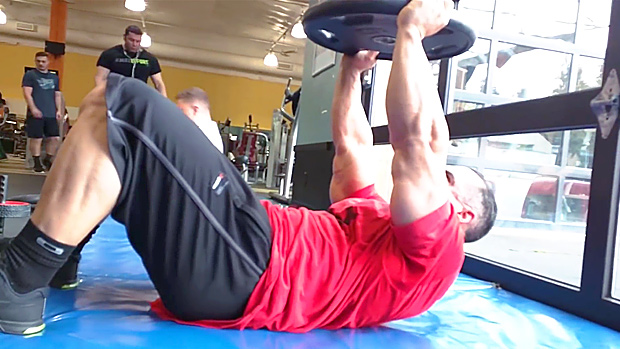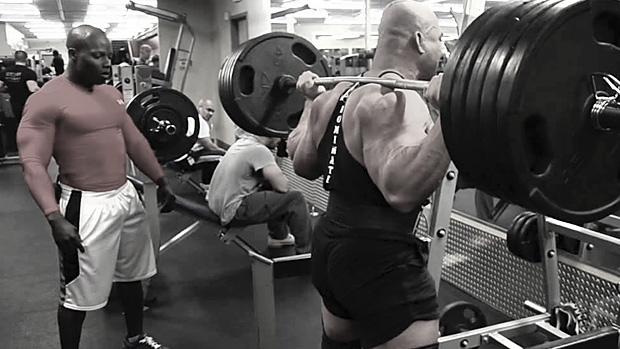Gaining muscle and losing fat simultaneously is known as body recomposition. It's a polarizing topic. Some say it's impossible. Others say it's the best way to reach your goals. Both are wrong.
The author of a recent scientific review on the topic, Chris Barakat, identified the key misconception that causes many to discount the possibility of recomposition. Most people go wrong by misinterpreting the laws of thermodynamics.
The Law of Thermodynamics proves that:
- To build muscle, you must store energy or increase muscle protein.
- To lose fat, you must burn energy or reduce stored body fat.
The mistake? To assume that:
- You must be in an energy surplus to build muscle.
- You must be in an energy deficit to lose fat.
Barakat says, "These assumptions aren't that clear-cut because our skeletal muscle and fat tissue are two different functioning compartments of your body which signal different metabolic processes that require different amounts of energy, totally independent of one another."
In the studies, recomposition is often the norm, not the exception. Based on the research and the anecdotal evidence I've seen with my clients, I'm confident that recomposition is possible. In fact, under the following five circumstances, it's probably the best approach to take:
- As a complete beginner
- After a long layoff from training
- When you finally start to train properly
- If you've been training properly, but your diet was poor, and you dramatically improve it
- If you take performance-enhancing drugs
Outside of these conditions, however, recomposition is extremely hard to achieve. But if you're up for the challenge, read on.
Recomposition is difficult, not impossible. Assessing how difficult it is for you can be done on a sliding scale based on three factors:
- Training age
- Training status
- Body fat percentage
Let's look at each:
1. Training Age
This describes how long you've been training. Someone new to training has a better chance at recomposition than someone who's been training for a decade.
2. Training Status
This is how advanced you are. It describes the quality and effectiveness of the training you've done in your lifting career. We all know people who've been going to the gym for years with little to show for it. A good metric of training status is how strong you are. If you're a bodybuilder posting elite-level powerlifting numbers, then you can consider your chances of recomposition slim.
3. Body Fat Percentage
The leaner you are, the less likely you are to recomp to any noticeable degree.
Based on these three factors, you can pinpoint how likely recomping is for you. With a low training age, low status, and high body fat, you have good odds for recomping. The window of opportunity to gain muscle and lose fat is large.
But if you have a high training age, high status, and are very lean, your chances of a recomp are slim to none. If this describes you, follow a cyclical approach of dedicated bulk and cut phases to continue building muscle and losing fat long-term.
You might think that lifestyle factors like sleep, diet, recovery methods, and stress levels must play a role in achieving a recomposition effect. You'd be right. I haven't covered these because body fat percentage and training status are the leading indicators.
Think of it this way: How many people do you know that eat a healthy diet, sleep 8-plus hours a night, and are obese and struggling for energy to work out?
On the other hand, if you eat like a kid at a birthday party, get less sleep than an insomniac, and have stress levels higher than a criminal under interrogation, then you're unlikely to have low levels of body fat and be crushing it in the gym.
I like efficiency, so rather than measuring superfluous metrics, take an honest look in the mirror to assess your training age, training status, and body fat. What looks back at you will quickly tell you if a recomp is on the cards for you.

If you're a dedicated lifter, you're probably stronger, more muscular, leaner, and more dedicated than the typical gym-goer. This is why I caution you against trying to recomp. It might not be the most efficient way. Let's take a deeper dive, and start with some research that actually supports the recomping strategy.
The scientific literature provides compelling evidence of the possibility of achieving recomposition effects. Here are some examples:
Researchers at the Norwegian School of Sport Sciences had 24 elite male and female athletes lift weights four days per week and either slowly or quickly lose weight.
Those who lost weight slowly maintained a moderate 500-calorie deficit. Those who aimed to lose weight quickly maintained an 800-calorie deficit. On average, the slow weight loss group lost about 0.7% of their body weight per week, and the fast weight loss group lost about 1% of their body weight per week.
Here's the interesting part:
- The slow weight loss group decreased their body fat by 8% and increased their overall muscle mass by 2%.
- The fast weight loss group didn't fare so well: they reduced their body fat by only 4% and actually lost muscle mass.
Alcaraz et al. found that participants following a specific training protocol gained 1.5kg (3.3 pounds) of lean mass and lost 1.5% of body fat in 8 weeks.
In another study, participants managed to gain 1.4kg (3 pounds) of lean mass and lose 2.4kg (5.28 pounds) of fat in only 6 weeks.
A study by Colquhoun et al. found that subjects training 6 times a week were able to gain 2.6kg (5.72 pounds) of fat-free mass and lose 0.1kg (.22 pounds) of body fat.
The exciting part about all of these studies is that participants didn't adjust their nutrition. They were all told to adhere to their normal eating.
If these results are possible without a nutritional intervention geared at optimizing results, imagine what's possible if you optimize workout nutrition and get your training and diet to work synergistically.
A study by Dr. Bill Campbell provides an excellent example of what's possible when diet is factored in. His study on female figure competitors investigated the difference that protein intake had on body composition: high (1.14 grams of protein per pound) versus low (.41 grams of protein per pound).
The high protein group gained 2.1kg (4.62 pounds) of fat-free mass while simultaneously losing 1.1kg (2.42 pounds) of fat mass, despite eating an average of 423 calories MORE per day than the low-protein group. Both groups underwent the same training protocol. This illustrates the power of nutrition!
While the research on recomposition is exciting, remember that you're not the standard participant in these studies.
Scientists at the University of Texas Southwestern conducted a study with participants who are (likely) more similar to you. They studied advanced male and female bodybuilders and found they were only able to squeeze out a small, insignificant, almost immeasurable increase in biceps size after almost 6 months of training. This was while bulking in a robust calorie surplus and an intense training protocol.
Proponents of body recomposition often sell unrealistic results. What they describe sounds too good to be true... because it is for the more advanced.
Recomposition can be effective, but it's a relatively short-term strategy. You can't recomp indefinitely and gain 25 pounds of muscle while getting leaner.
Those who think recomping is a long-term strategy end up "gaintaining" rather than recomping. Instead of losing fat and gaining muscle, they achieve neither. They spin their wheels and never look any different. These failed attempts and the unrealistic expectations are why I so often warn people about making recomposition their goal.
Granted, that doesn't mean you should completely give up on recomping. Just be realistic.
For advanced lifters, a recomposition is actually just a good dieting phase. Or alternatively, a dieting phase done well will have a small recomposition effect. That's the key point.
This is going to sound weird but think of a recomposition as an opportunity to lose fat and gain a smidge of muscle. It's not a chance to gain muscle and lose fat. That may seem like semantics, but the priority is key.
You can build a small bit of muscle during a deficit if your training and diet are on-point. But to build a lot of muscle, you need a significant calorie surplus. And if you do that, you won't lose fat.
If you think of re-comping as an approach to get noticeably leaner while gaining a fraction of muscle mass, you'll be pleasantly surprised.
Now, if you want to temporarily diet down to very low levels of body fat while striving to gain a little muscle mass, you can. But you're going to need to be strategic to do it.
What type of strategies? We'll go through each, but first, you have to look at it as a short-term solution.
Even for the most dedicated bodybuilders, there's a limit to how long you can maintain the discipline to tick all the boxes required to achieve recomposition. The attention to detail needed for every element of your training, diet, recovery, and supplementation are draining.
It's not just a mental battle but a physical one. Eventually, your body adapts to whatever stimulus you throw at it. To overcome this, you need a robust signal to force it to keep progressing.
An effective recomp relies on a moderate enough calorie intake and training volume to allow for a slow(ish) rate of fat loss. Why? Because if you lose too quickly, the chances of gaining muscle evaporate.
The approach to a recomp is moderate in terms of calorie restriction. It's not an assertive enough stimulus to push past adaptive resistance. There will come a point where you either have to slash calories to get leaner or increase them to gain muscle.
I suggest an 8-12 week window for a recomp. In most cases, 12 weeks is the maximum you can keep seeing good results.
This is long enough to drop a noticeable amount of fat at a slow-enough rate where you can also gain some muscle. To achieve the near-impossible, you need a great plan and perfect execution of it.
Commit to getting the absolute most out of yourself, your training, and diet for 12 weeks and then move on to either a dedicated bulk, cut or strength phase.

Keep your eyes on the prize to get what you want. The best way? Tie it to a clearly defined event or outcome.
Book a photoshoot, plan to step on stage in a physique show, or prep for a special occasion. These are all powerful motivators.
With a goal on the horizon and the added accountability it provides, people often find another level of commitment, dedication, and drive. They become more focused. While this is great for achieving the goal, their life becomes unbalanced. Burnout will creep in. So for short periods, leveraging this is a powerful tool. Long-term, however, it doesn't work.
Pick a predetermined, short timeframe within which you can push the limits. Make sure that you have a powerful reason to keep you motivated because you can't afford slip-ups when you only have 12 weeks.
You'll also need to focus on outcome-based decision making. The outcome is clear: lose fat and gain muscle. Make adjustments to your diet and training based on results, not emotion. It's tempting to want to train more and eat less because that "feels" effective, but this is a mistake.
The temptation is to do too much. When emotion takes over, logic disappears. It's easy to convince yourself that more training means a greater muscle-building stimulus and more calories burned. However, it doesn't take into account the big-picture view.
Ideally, fat loss is 0.25 to 0.5% of your weight per week. For a 200-pound guy, that's 0.5 to 1 pound per week.
The leaner you get, the higher your risk of muscle loss. So I tend to start lifters off at the higher end of the target rate of loss (0.5%) for the first few weeks. Then I throttle back and reduce the rate to 0.25% per week. This approach is extremely effective.
This is also known as your maximum adaptive volume (MAV). This is the amount of work that allows you to progress optimally without eating into your recovery threshold.
Remember that your calories will be relatively low when trying to recomp. With lower calories comes less energy and tolerance for overall training volume. If you do too much, you'll risk muscle loss, overtraining, injury, and driving cortisol so high that muscle gain and fat loss will be blunted.
To ballpark your MAV, take the number of sets you do for a body part at the peak of your bulk and reduce it by about 10%.
Not sure what your peak bulking volumes are for each muscle group? Use the published data as a starting point. Doing 8-12 hard sets per muscle group per week is a good rule of thumb.
Try hitting each muscle group twice a week for optimal results. That means training each muscle group with 4-6 sets per session.
Eating a gram of protein per pound of bodyweight is reasonable. But for recomposition, you need to do better than reasonable. You need optimal. The research indicates that when your calories are lower, a higher protein intake helps you to retain muscle mass.
The recomposition research is the same. Recomp researchers generally recommend eating between 1.2 to 1.6 grams per pound of fat-free mass. To make life simple, go with 1.2 grams per pound of body weight.
Effective recomposition is all about attention to detail: the aggregation of marginal gains. These small gains can add up to have a profound effect. One such example is taking care of your workout nutrition.
Using something like Surge® Workout Fuel before and during your workout would do the job nicely.
Recomposition is certainly possible. To make it work for you, you must first conduct an honest assessment of your current training status and body fat levels. If you're already very lean and an advanced lifter, it probably isn't the right choice for you. If, however, you believe you have some scope to recomp, then go for it. Just try to remove emotion from your decision making. Use outcome-based decisions to guide you and strive to optimize every detail you can.
Even if you've been training for years, you probably have room to improve your training program, intensity, effort, nutrition, and supplement protocols. If you pay attention to all of these in extreme detail for the next 12 weeks, fat loss and muscle gain are there for the taking.
Progress at an appropriate rate (fat loss should be slower than a full-on cut to allow for muscle gain to occur), and your patience will be rewarded.





